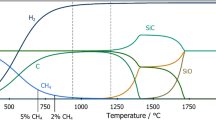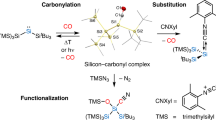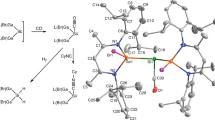Abstract
THE potential role of inorganic and organometallic silicon compounds in the development of new chemical reagents, polymers, glasses and ceramics1 is limited at present by the paucity of simple silicon-containing starting materials. Whereas industrial carbon-based chemistry can draw on the diversity of compounds produced from crude oil, coal or other natural sources, silicon chemistry2 relies almost exclusively on the carbothermal reduction of SiO2 to silicon. This is then transformed into feedstock chemicals by reaction with HCl, or by routes such as the 'direct process' for making methylchlorosilanes2, in which silicon is reacted with methyl chloride at 200–350°C over a copper/tin catalyst. Organosilicon compounds are in demand in fields ranging from organic synthesis to ceramics to the electronics industry. New synthetic routes to these materials are therefore highly desirable, especially if they rely on low-cost SiO2 and on rocessing methods that avoid the energy-intensive and equipment-intensive carbothermal reduction step which currently precedes almost all silicon chemistry. Here we describe a direct process in which SiO2 is reacted with ethylene glycol and an alkali base to produce highly reactive, pentacoordinate silicates which provide access to a wide variety of new silicon compounds.
This is a preview of subscription content, access via your institution
Access options
Subscribe to this journal
Receive 51 print issues and online access
$199.00 per year
only $3.90 per issue
Buy this article
- Purchase on SpringerLink
- Instant access to full article PDF
Prices may be subject to local taxes which are calculated during checkout
Similar content being viewed by others
References
Inorganic and Organometallic Polymers with Special Properties (ed. Laine, R. M.) NATO ASI Series E: Appl. Sci., No. 30 (Kluwer, Dordrecht, 1991).
Kirk-Othemer Encyclopedia of Chemical Technology, 3rd Ed., Vol. 20, 750–880 (Wiley-lnterscience, New York, 1979).
Boudin, A., Cerveau, G., Chuit, C., Corriu, R. J. P. & Reye, C. Angew. Chem. Int. Ed. 25, 473–474 (1986).
Corriu, R. J. P., Perz, R. & Reye, C. Tetrahedron 39, 999 (1983).
Boudin, A., Cerveau, G., Chuit, C., Corriu, R. J. P. & Reye, C. Organomet. 7, 1165–1171 (1988).
Rosenheim, A., Raibmann, B. & Schendel, G. Z. anorg Chem. 196, 160 (1931).
Barnum, D. W. Inorg. Chem. 9, 1942 (1970).
Barnum, D. W. Inorg. Chem. 11, 1424 (1970).
Kenney, M. E. & Goodwin, G. B. US Patent No. 4,717,773 (January 1988).
Frye, C. L. J. Am. chem. Soc. 92, 1205–1210 (1970).
Tandura, S. N., Voronkov, M. G. & Alekseev, N. V. Topics Curr. Chem. 131, 99–186 (1986).
Swamy, K. C. K. et al. J. Am. chem. Soc. 112, 2341–2348 (1990).
Holmes, R. R. Chem. Rev. 90, 17 (1990).
Holmes, R. R., Day, R. O. & Payne, J. S. Phos. Sulf. Silicon 42, 1–13 (1989).
Laine, R. M., Ray, D. J., Viney, C. & Robinson, T. R. Am. chem. Soc. Polym. Preprints 32, No. 3, 550 (1991).
Fujita, M. & Honda, K. Polymer Commun. 30, 200 (1989).
Spindler, R. & Shriver, D. F. J. Am. chem. Soc. 110, 3036 (1988).
Levin, E. M., Robbins, C. R. & McMurdie, H. F. Phase Diagrams for Ceramists, 5th Printing (eds. Reser, M. K.) 87–92 (American Ceramic Society, 1985).
Bickmore, C. R. et al. 5th Int. Conf. infrastructure Processing (eds Hench, L. L., West, J. K. & Ulrich, D. R.) (Wiley, New York, in the press).
Author information
Authors and Affiliations
Rights and permissions
About this article
Cite this article
Laine, R., Blohowiak, K., Robinson, T. et al. Synthesis of pentacoordinate silicon complexes from SiO2. Nature 353, 642–644 (1991). https://doi.org/10.1038/353642a0
Received:
Accepted:
Issue Date:
DOI: https://doi.org/10.1038/353642a0
This article is cited by
-
Conjugation in polysiloxane copolymers via unexpected Si-O-Si dπ-pπ overlap, a second mechanism?
Polymer Journal (2024)
-
Anionic silicate organic frameworks constructed from hexacoordinate silicon centres
Nature Chemistry (2017)
-
Harvesting silica nanoparticles from rice husks
Journal of Nanoparticle Research (2011)
-
Synthesis of 4-vinyl benzyl tetra-coordinate silicate monomer
Polymer Bulletin (2007)
-
A new method for dissolution of silica gel in a pentafluoropropionyl fluoride—tertiary amine system
Russian Chemical Bulletin (2007)
Comments
By submitting a comment you agree to abide by our Terms and Community Guidelines. If you find something abusive or that does not comply with our terms or guidelines please flag it as inappropriate.



